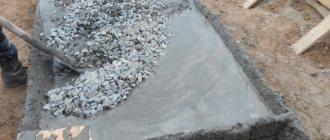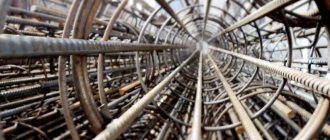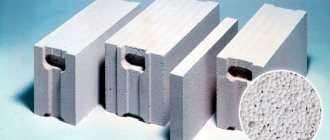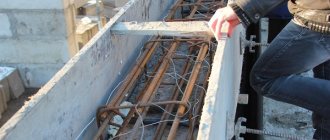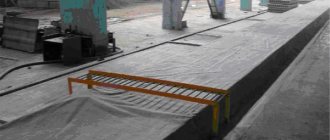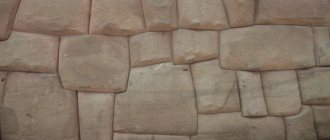During large-scale or repair concrete work, situations often arise when it is not possible to simultaneously pour the entire concrete structure.
As a result, cold seams appear at the point of contact between concrete layers, which lead to loss of strength, loss of water resistance, peeling and other “troubles.”
In this regard, when repairing concrete and reinforced concrete structures, as well as when constructing screeds, it is necessary that the adhesion of concrete to concrete is as deep and reliable as possible.
The main reason for poor adhesion of concrete to concrete and, accordingly, the reason for the formation of cold joints and delamination is the natural process of carbonation of concrete.
Free lime, as the main source of functional interaction between concrete layers, is practically absent on the surface of “old” concrete.” Under the influence of ambient CO2, active lime transforms into calcium carbonate, which is an inert substance that reacts only with acidic compounds.
Therefore, fresh concrete, which has an alkaline reaction, “adheses” very poorly to the old carbonized surface, and if adequate measures are not taken, over time it forms cold seams or “comes off.”
Adhesion Determination
Thanks to this phenomenon, paint and plaster are firmly held on the walls and ceiling, and concreting is possible. As it becomes clear, it is responsible for gluing the surface or base to the coating.
Adhesion is the cohesion of dissimilar substances. In construction, this term refers to the ability of a particular coating (for example, paint, plaster) to firmly adhere to the surface of the base.
Adhesion is divided into physical and chemical:
- In the first case, the connection occurs due to the adhesion of the molecules of the materials.
- In the second - due to the chemical effects of substances.
The intensity of bonding is measured in MPa (megapascals). This number indicates the force that will have to be applied to separate the coating from the base. For example, if the label says that the product provides adhesion of 1 MPa, then to tear it off you will have to apply a force of 1 N per mm2 (about 100 g/mm2).
Adhesive properties are one of the main characteristics for any coating, decorative or protective. The strength and reliability of the connection, the possibility of gluing certain types of materials, the comfort or complexity of the work depend on them.
What it is?
Concrete and brick are capable of absorbing moisture, so liquid soil compositions are often used to improve the indicator.
This property determines how well the finishing materials adhere to the concrete surface.
Adhesion is the property of a material to adhere to another medium. The result of facing work depends on this quality. The indicator is measured in kgf/cm2 or MPa and indicates the force required to break the elements. Adhesion occurs between liquids, solids, or objects of different consistencies. To measure the indicator, mechanical or methods without physical intervention are used. This property characterizes the quality of adhesion to wallpaper or paint. Since artificial stone has low adhesion, special treatment of the concrete surface is required to securely fasten these facing materials.
View "GOST 28574-90" or
For which materials is adhesion important?
This indicator is of primary importance for construction and finishing compositions. It is imperative to pay attention to the level of adhesion for the following types of coatings:
- Varnishes and paints. This property affects the quality of adhesion, penetration depth and durability of the coating. The higher the indicators, the better and longer the paint and varnish materials will last on the base.
- Gypsum mixtures. The quality of adhesion determines the possibilities of decorative finishing.
- Cement-sand compositions. The safety of the structure often depends on the reliability of gluing. For example, if you use substances with poor adhesion, the brickwork will not last long.
- Sealants and other adhesives. Here you need to know between which materials the product can ensure adhesion. When using unsuitable mixtures, the quality of the connection deteriorates, and in some cases becomes completely impossible.
USEFUL INFORMATION: How to calculate the area of walls and floors
A special device, an adhesive meter, allows you to measure the adhesion ability of materials and control the quality of adhesion of the coating to the base.
V I Torkatyuk, N M Zolotova - Bonding old concrete with new - page 1
Scientific and technical collection No. 42
0 2 4 6 in 10 13 14 1 in 16
Fig. 2 - Result of slope stability calculation
UDC 624.011.2: 668.3
V.I.TORKATYUK, Doctor of Engineering. Sciences, N.M. ZOLOTOVA Kharkov State Academy of Municipal Economy
BONDING OLD CONCRETE TO NEW
Data is provided on various materials, their strength and technological properties used to connect old concrete with new, as well as the main technological examples of monolithic old concrete with new.
During the construction of industrial buildings and structures, monolithic concrete and reinforced concrete structures, as a rule, are erected with a break in concreting: layer-by-layer construction of massive foundations; erection of structures of complex configuration, when it is impossible to completely install the formwork for the entire volume. During reconstruction, work is carried out to restore and change the dimensions and configuration of structures. To ensure adhesion, a thin layer of glue is applied to vertical, inclined or horizontal planes of old concrete. A layer of new concrete is then laid down before it cures, compacted by vibration (picture).
In these cases, when laying concrete in the working joints between the old and newly laid concrete, weak spots are formed in the structure, due to the presence of which the reinforced concrete loses its monolithic property. The main reason for this phenomenon is the reduced degree of adhesion between layers of concrete laid at different times. The structure becomes weaker in shear resistance, sensitivity to moisture infiltration and the penetration of dissolved substances dangerous to concrete or reinforcement appears. The resistance to low and high temperatures, alternating and repeated forces is significantly reduced.
Adhesive connection of old and new concrete: 1 - new concrete; 2 - adhesive layer; 3 - old concrete
To improve adhesion and increase the strength of the connection between old and new concrete, you can add special additives to the newly laid concrete or use polymer solutions or adhesive materials to seal the joint.
When concrete grows together along a seam, the following processes are observed. When concrete on Portland cement is joined, as a result of chemical reactions occurring in the joining planes, Ca(OH)2 crystals are formed, connecting both concretes into one whole and serving as a “crosslinking”. The adhesion force caused by this phenomenon is small in the initial period, and at this time careful care of the concrete is necessary to ensure the completeness of its hardening reactions, as well as the use of measures to promote complete contact of the concrete.
The adhesion process depends on the properties of both the new concrete (chemical activity, plasticity) and the old one in contact with it (porosity, water absorption, adsorption, roughness). In most cases, the adhesion of one material to another is determined simultaneously by several phenomena: molecular and electrical attraction between particles; merging at the interface of crystals of substances formed during the hardening of the binder with the crystals of the material in contact; the formation of new substances as a result of a chemical reaction between the binder and the material in contact with it.
Indeed, the surface of old concrete is a hardened cement stone that envelops the filler. Thus, the adhesion of old and new concrete will be carried out on a surface that does not have adhesive ability. The presence of coarse and fine aggregates in the new concrete also does not predetermine the adhesive ability of the new concrete. The only factor that can carry out bonding at the contact is uncured cement mortar, which has insignificant adhesive properties. The strength of the connection in this case is significantly less than the cohesive strength of monolithic concrete.
An increase in the adhesive ability of new concrete to old occurs with the introduction of plasticizing additives, as well as some hardening accelerators (CaCl 2, Na 2 C 03, liquid glass).
During the construction and repair of underground structures, colloidal cement mortar with additives is used [1,2]. To plasticize it, divinyl styrene latex SKS-65 GP or butadiene methyl methacrylate is introduced. Polyamide resin No. 39 in an amount of 0.5 mass of cement, water-soluble epoxy resin DEG-1, and divinyl styrene latex SKS-65 GP are used as polymer additives [1].
The introduction of SKS-65 GP latex in an amount of 10-20% of the cement mass makes it possible to reduce the deformation modulus of concrete by 2-2.5 times to (1-1.5)104 MPa instead of (3-3.5)-104 MPa for conventional concrete. However, the presence of latex sharply reduces the water resistance of the seam.
To bond old concrete to new, polymer adhesives and compounds are used that have increased water resistance, strength, crack resistance, and high adhesion to concrete.
Polymers containing hydroxyl, carboxyl, epoxy and other polar groups capable of providing hydrogen bonds with surface hydroxyls, as well as ion-dipole and chemical interactions, have high adhesion to concrete. Since adhesion is mainly determined by chemical bonds, its highest indicator should be expected at points of contact with Si 02. However, at the contact of concrete with the polymer there are no new formations caused by the chemical interaction of the adhesive and the substrate.
Municipal utilities of cities
When choosing adhesives, you should consider not only their strength, but also their reliability and durability. A special role is played by internal stresses and relaxation agents, which, under the conditions of formation and operation of adhesives, often predetermine their behavior over time.
To repair reinforced concrete and connect its individual elements, adhesives of various compositions based on epoxy resins are widely used [3]. They have a wide range of technological viability due to the use of combined hardeners. A technology has been developed for gluing concrete surfaces at subzero ambient temperatures using conductive gaskets made of epoxy glue. Their use for joining concrete is advisable for small gluing areas, determined primarily by the technological characteristics of the adhesive. The high viscosity of filled epoxy adhesives, their relatively low technological viability, high cost and difficulty in processing large masses of adhesive make it difficult to use them for connecting old and new concrete during the construction of massive monolithic structures. Therefore, for gluing concrete it is necessary to use technologically advanced, cheap adhesives that can be easily applied over large areas.
Methods for increasing adhesion
The adhesive properties of materials can be either improved or worsened. This is not a constant value. For example, various impurities are added to surface-applied formulations to enhance penetration and adhesion. Substances that act as an intermediate layer are used, such as special primers or contact fluids.
Degreasing the surface is another sure-fire method of enhancing adhesion.
To increase adhesion, a whole range of measures are used to influence the physical and chemical properties of the material. There are 3 methods of surface preparation that improve adhesion:
- Mechanical. This can be abrasive treatment to roughen it, apply notches, as well as clean it from dust and any contaminants.
- Chemical. Mixing special additives and plasticizers into the applied solution.
- Physico-chemical. This includes treatment with primers, as well as puttying.
Such methods are most effective when bonding dissimilar surfaces with different physical and chemical properties.
In addition, there are a number of factors that reduce the quality of adhesion of materials:
- It is almost impossible to glue dusty or greasy surfaces without pre-treatment with cleaning and degreasing compounds.
- The quality of adhesion will be very low even if one or both surfaces are treated with a composition that reduces porosity.
- Adhesive properties may deteriorate as materials set and dry. When transitioning from a liquid to a solid state, the chemical and physical properties of substances can change. For example, many solutions shrink. As a result, the area of contact with the base is reduced. Then tensile stresses appear, due to which, in turn, cracks form. As a result, the adhesion of materials becomes less strong and unreliable.
A simple example. If you plaster a concrete wall without proper preparation, the coating will quickly fall off. This is due to many factors, which include:
- dusty surface;
- shrinkage of the plaster layer;
- absence of additives that enhance adhesion, etc.
USEFUL INFORMATION: How to properly putty a plasterboard ceiling with your own hands
Therefore, when working with old concrete, you should use an integrated approach, which requires:
- thoroughly clean the surface;
- apply notches with an ax or hammer drill;
- treat with a special primer that enhances adhesion;
- add a plasticizer to the plaster, which increases the elasticity of the solution.
How to improve?
The adhesion of building materials is negatively affected by the ingress of gasoline, acids, oils, fats, and alkalis, so in this case it is recommended to degrease the surface.
Applying fresh concrete, plaster or wallpaper to an unprepared surface causes these materials to crack and fall off. Therefore, during repair work the following recommendations should be followed:
A special primer will help solve this problem.
- A dusty surface impairs adhesion and must be removed.
- If the surface is not rough enough, then a special primer is used or notches are made.
- The adhesion of concrete to metal is of low importance, so additional additives are used to hold these materials together. In addition, one of the means that improves adhesion is construction foam.
- Plasticizers for the solution increase its plasticity, which contributes to better adhesion.
Taken together, all these measures will ensure reliable adhesion of the fresh concrete mortar to the old coating. Therefore, you should not skimp on preparing the wall or floor, as the result will be negative, and the new surface will crack and delaminate. This will entail the need to redo the work.
Adhesive properties of paints and varnishes
The ability of paintwork materials to adhere depends primarily on the surface on which they are used.
- Adhesion reaches its maximum values when processing rough materials. This is due to the fact that on a smooth surface the area of contact with the paintwork will be much smaller.
- Another factor is the structure of the material being processed. Thus, when covering a porous surface with paintwork materials, the composition penetrates into the base. Consequently, it will be possible to remove a layer of paint or varnish only if it is possible to break the molecular bonds of the coating or base (for example, as when sanding).
In addition, the ability to adhesion is increased by various modifying additives that are used in the manufacture of paints and varnishes:
- organosilanes, which prevent corrosion and have a water-repellent effect;
- organometallic substances acting as catalysts for chemical processes;
- polyesters;
- various fillers and ballast substances (for example, talc);
- esters of rosin and phosphoric acid;
- polyamide resins;
- polyorganosiloxanes.
Terms of use
Basically, the adhesive additive works as a plasticizer. To work with screed mortar, you need to add glue in an amount of 5% -10% or 0.5 liters of PVA per 2-3 buckets of cement. If you plan to lay tiles, then it is better to take 20% or more polyvinyl acetate.
The glue should be mixed after diluting it with water. This will result in a more homogeneous mass at the end. However, if you need a composition with high adhesion and plasticity, it is better to mix cement with glue without first dissolving it in water.
Adhesion to concrete
Currently, concrete is one of the most famous and widely used building materials. It is concrete slabs that most often act as the bases of walls, ceilings and floors in an apartment. Due to the smoothness of the surface of these slabs, the adhesion of various finishing compounds to them is often very weak.
To ensure good adhesion to this material, many points must be taken into account:
- Adhesion to a dry surface is several times higher than to a wet one.
- This characteristic of concrete itself, such as the compressive limit, directly determines the quality of adhesion of various polymer materials to it.
USEFUL INFORMATION: The process of leveling walls using beacons with your own hands step by step: how to place beacons
- The use of special compounds and primers can significantly improve the quality of surface adhesion to the coating.
- When applying various compounds (glue, putty, paint, plaster), the humidity and temperature of both the base and the air in the room should be taken into account.
- Adhesion to a rough surface is always higher than to a smooth one.
Roughness can be achieved in different ways, one of them is by applying a special primer “Betonokontakt” (“Betokontakt”, “Beton contact”, etc., the name varies depending on the manufacturer). Thanks to the content of cement and quartz sand, the soil turns a smooth surface into a rough one, reminiscent of fine-grained sandpaper.
Thus, thanks to the phenomenon of adhesion, high-quality adhesion of the coating materials to the base is ensured. Without this, paints and varnishes would immediately fall off the treated surface, and it would be impossible to apply decorative finishes or plaster the walls. Each type of material has a certain level of adhesion ability. At the same time, many external conditions can either increase or decrease it.
Choosing glue to glue plastic and metal
To solve this problem, several types of adhesives are suitable: polyurethane, epoxy, contact. They form a strong connection with both metal surfaces and plastic. It is important to remember: for outdoor work you should take waterproof products so that they do not lose strength under the influence of atmospheric moisture.
Polyurethane glue
Polyurethane-based compositions have many useful qualities. They are resistant to high humidity, do not soften when heated, and are suitable for gluing a wide variety of materials, from paper to plastic and metal. An additional advantage is the absence of chlorine-containing solvents. An example is HOLZ-R PUR 501 adhesive, which is used for gluing non-absorbent surfaces. Polyurethane adhesive is used both indoors and outdoors.
Cement waterproofing is a worthy alternative to bitumen
Even the ancient Romans modified lime by adding crushed pozzolans (volcanic ash from the slopes of Vesuvius). Masonry mortar prepared with such lime became stronger and absorbed much less water. It took people a couple of thousand years to finally, in 1844, accurately identify the components and invent the correct technology for producing a durable composition (a binder in construction terminology), called cement. Caementum is what the Romans called crushed stone. Since the beginning of industrial production, cement has been widely used as a waterproofing material. In Soviet times, for horizontal waterproofing of foundations and walls, a cement-sand mortar was used, mixed in a 1:2 ratio and applied in a small layer to a concrete pad. The so-called “ironization” is the result of rubbing fresh concrete or mortar with pure cement, giving it high strength and repelling water.
Classification of dental cements
Adhesives are divided into several types depending on their composition. The oldest is zinc phosphate, which is still relevant and has good properties and low cost. However, composite cements are increasingly used in modern dental practice.
Glass ionomer
This type of cement is most often used for temporary filling; it is used to fill the entire tooth or defect site for a short period of time. Glass ionomer dental cement contains different types of polymers, so they are divided into two types:
- chemical rejection;
- light rejection.
The set contains a liquid phase (polyacrylic acid) and a powder (glass powder with fluorine).
Scope of application and properties of glass ionomer powder:
- In pediatric dentistry for the restoration of baby teeth for the purpose of installing permanent fillings.
- For laying under fillings.
- Good wear resistance - up to 5 years, can be used even in areas of high chewing load.
- Biocompatibility with dentin.
- Taking care of caries prevention.
- No harmful effects on the pulp.
- Gentle action.
- Small color palette.
Features of application
Before determining the proportions of adding PVA to cement, it is necessary to note which type of this glue is not suitable for construction purposes. This is primarily PVA intended for paper and cardboard products. It contains too much starch and other fillers. Also, you should not take PVA for wood, as it also contains various unnecessary additives.
The second important point is the purpose of the solution. Because the proportions of cement with PVA will be different. For a screed, certain properties are needed, and for laying ceramic tiles, others are needed. And the last nuance is what humidity will be in the room. Despite the fact that after the glue hardens, it polymerizes and is not afraid of moisture, however, it is still not recommended to use it in wet rooms (bathtub, shower room, swimming pool).
Another feature is the temperature regime. Although the glue can withstand high and low temperatures, in order not to risk the final result of reliability and durability, it is better that the temperature be higher than +7 ° C.
Dry mixture (sand+cement) R-10, “Diana”, 5kg
Price for a one-time order in the amount of 500,000 rubles.
Price for a one-time order in the amount of 100,000 rubles.
| Available: | 208 pcs. |
| Code | S-000117010 |
| Brand | Diana |
| Weight, kg | 5 |
| Country of origin | RUSSIA |
| Quantity per package | 5 pieces. |
| Base material | concrete, Wood, Metal, Plywood |
Dry mixture of plastering and masonry (universal) R-10
Designed for plastering walls, ceilings, masonry work, concreting stairs, repairing floors, sealing concrete, walls and areas of fallen plaster.
Apply to concrete, cement-lime, cement-sand, brick bases.

